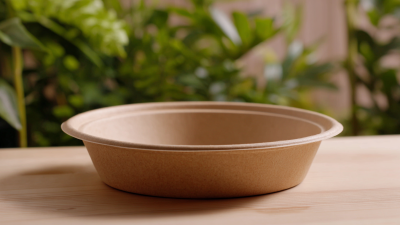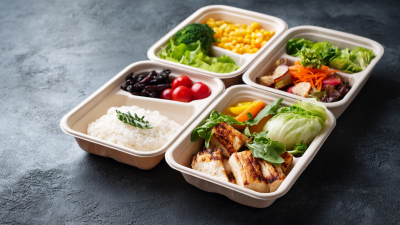As consumers increasingly prioritize sustainability in their purchasing decisions, biodegradable disposable plates have emerged as a viable alternative to traditional single-use plastics. According to a report from the EPA, approximately 40% of total waste in the United States comes from food-related expenditures, with disposable tableware contributing significantly to this statistic.

The market for biodegradable products is projected to reach $9.57 billion by 2025, as consumers become more aware of the environmental impact of their choices. Biodegradable disposable plates, made from materials that break down naturally over time, offer an eco-friendly solution that reduces landfill waste and pollution. With their growing availability and acceptance, these plates not only meet the demand for convenience but also align with the increasing commitment to sustainable living.
As we delve into the benefits of biodegradable disposable plates, it becomes clear why they are a compelling choice for today’s environmentally conscious consumers.
Traditional disposable plates, commonly made from plastic or styrofoam, pose significant environmental challenges. According to the Environmental Protection Agency (EPA), approximately 10.5 million tons of plastic waste are generated annually in the United States alone, much of which ends up in landfills and oceans. These materials can take hundreds of years to decompose, leaching harmful chemicals into the soil and waterways during that time. Additionally, research by the World Economic Forum indicates that if current production and consumption patterns continue, there could be more plastic than fish in the oceans by 2050.
Beyond just the longevity of waste, the production of traditional disposable plates requires substantial natural resources, further exacerbating environmental concerns. For instance, the process of manufacturing styrofoam emits greenhouse gases, contributing to climate change. A study published in the journal *Environmental Science & Technology* found that the lifecycle impact of single-use plastics, including disposable plates, is approximately 2.5 times greater than that of biodegradable alternatives. This stark contrast emphasizes the urgent need for consumers to shift towards more sustainable options, like biodegradable disposable plates, which can provide functional convenience without inflicting the same level of harm on the planet.
Biodegradable materials are increasingly gaining attention as sustainable alternatives to conventional plastics, particularly in the context of disposable plates. What sets biodegradable materials apart is their ability to break down naturally in the environment without leaving toxic residues. Made from organic substances like corn starch, sugarcane, or bamboo, these materials undergo a natural decomposition process facilitated by microorganisms, offering an eco-friendly solution for single-use items.
One of the key distinctions of biodegradable disposable plates lies in their production methods and end-of-life behavior. Unlike traditional plastic plates that can take hundreds of years to decompose, biodegradable options typically decompose within months when placed in composting environments. This rapid breakdown helps reduce landfill waste and minimizes the environmental impact associated with plastic pollution. Additionally, many biodegradable materials are designed to be compostable, meaning they can enrich soil when decomposed properly, contributing to a more sustainable cycle of life.
When planning events, choosing the right disposable tableware can greatly impact both the experience of guests and the environment. Biodegradable plates offer a sustainable choice that aligns with the growing consumer demand for eco-friendly options. According to a 2022 report from the Biodegradable Products Institute, the market for biodegradable products is projected to grow by 10% annually as more consumers seek alternatives to traditional plastics. This shift is driven by increasing awareness around the environmental impacts of waste, particularly single-use plastics that often end up in landfills or oceans.
 Biodegradable plates are made from materials like corn starch, sugarcane, or bamboo, which are designed to break down naturally over time. Research indicates that these plates can decompose within 90 to 180 days in a commercial composting facility compared to years or even centuries for plastic plates. Events that utilize biodegradable tableware not only reduce their carbon footprint but also appeal to an environmentally conscious audience. A study published in the Journal of Environmental Management found that 70% of consumers are more likely to choose a brand that demonstrates commitment to sustainability, highlighting the growing market preference for eco-friendly event supplies.
Biodegradable plates are made from materials like corn starch, sugarcane, or bamboo, which are designed to break down naturally over time. Research indicates that these plates can decompose within 90 to 180 days in a commercial composting facility compared to years or even centuries for plastic plates. Events that utilize biodegradable tableware not only reduce their carbon footprint but also appeal to an environmentally conscious audience. A study published in the Journal of Environmental Management found that 70% of consumers are more likely to choose a brand that demonstrates commitment to sustainability, highlighting the growing market preference for eco-friendly event supplies.
Biodegradable disposable plates have emerged as a crucial solution in the fight against waste, especially in a world increasingly concerned about climate change. Research indicates that 89% of consumers are now opting for sustainable products, highlighting a significant shift toward environmentally-friendly alternatives. This transition aligns with the growing demand for items that are not only functional but also contribute to reducing landfill waste. Unlike traditional plastic plates, biodegradable options are designed to break down naturally, minimizing their impact on the environment.
By using biodegradable plates, consumers can dramatically reduce the volume of single-use plastics that often end up in landfills and oceans. Events and gatherings that focus on sustainability are increasingly adopting these products, reinforcing the message of responsible consumption. Additionally, educational initiatives targeting schools, such as those conducted in Hangzhou, emphasize the importance of resource recycling and low-carbon living, fostering a generation that prioritizes eco-friendly practices. As consumers become more conscientious about their choices, biodegradable disposable plates stand out as a viable, sustainable alternative that supports a circular economy and promotes a greener future.
When choosing biodegradable disposable plates, it's essential to understand what materials are truly sustainable. Look for plates made from natural fibers like bamboo, palm leaves, or sugarcane. According to a report by the Biodegradable Products Institute, products made from these materials can break down in composting facilities within 90 to 180 days, unlike traditional plastic plates which can take hundreds of years to decompose. Additionally, ensure the plates have certifications indicating they meet environmental standards, such as ASTM D6400 or EN 13432, which verify their compostability.
Another critical factor is the plate’s durability and use case. For instance, if you're hosting a barbecue or a festive outdoor gathering, opt for thicker and sturdier plates designed to support heavier meals. Research from the International Biodegradable Products Association shows that consumer preferences are shifting towards durable biodegradable options, with 60% of consumers finding them suitable for meals similar to traditional plastic offerings. Always check the temperature tolerance of the plates as well; many eco-friendly products can withstand both hot and cold foods, making them versatile for various occasions.






